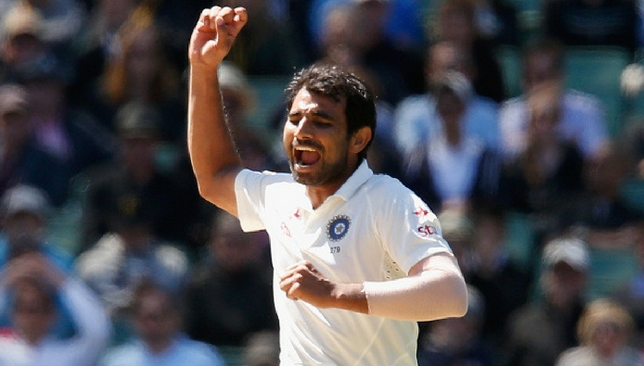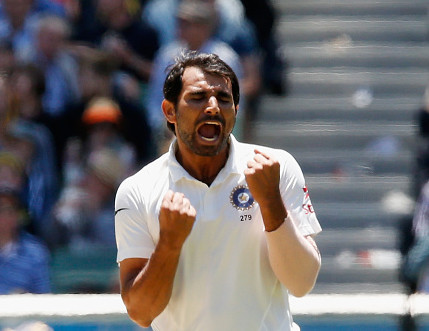
New Zealand’s first innings in Kolkata: BJ Watling tried hard to string together little partnerships with the lower-order in a bid to shave important runs off India’s lead.
In came Mohammed Shami, with the ball reversing, and trapped him plumb LBW, the batsman left rooted to his crease unable to do anything about that hint of movement into his pads.
In the second innings, when facing Shami again, Watling knew better. The ball was 60 overs old, and reversing a bit, again. This time, the batsman plonked his front foot forward, thinking it would be enough to cover a similar incoming line.
The bowler bowled a peach though, as the ball did pitch outside off but came in just enough to beat the bat. And the stumps were knocked back!
Arms outstretched as if he was flying, almost gliding like Shoaib Akhtar was once seen at the Eden Gardens, there was a certain joy in Shami’s bowling. Perhaps, the ground played its part, for this was his home turf. He knows when to bowl from which end, and what angles to use.
Unlike the Test in Kanpur when he was only used sparingly, the situation in Kolkata for the second Test proved very different.
It underlines two vital points.
Daughter in the ICU but still running in hard and handing India a victory. Respect your courage @MdShami11 Hope the little one is better now
— Aakash Chopra (@cricketaakash) October 5, 2016
First, India have coped well in the absence of Ishant Sharma (nursing an illness). And second, in this four-bowler theory, depending upon conditions they have chosen to rotate the second pacer – Umesh Yadav played in Kanpur, and Bhuvneshwar Kumar was picked in Kolkata.
As things stand then, Shami is Virat Kohli’s strike weapon.
“He makes an impression on the game regardless of the surface he is playing on,” remarked the Indian skipper ahead of the third Test in Indore.
His words follow the sequence of events from the recent West Indies tour. Shami’s return to fitness was one of the major positives of that trip.
It could be seen in Antigua first, when he played a Test after nearly one-and-a-half years. A shorter stride in his run-up was visible, allowing him to work up more pace and on dead pitches in the Caribbean, his bouncer became a surprise weapon.
The Bengal pacer finished with 11 wickets in four Tests, playing variable roles at times – second fiddle to Ishant or Bhuvneshwar, or attacking particularly when there was reverse swing on offer.
Strike bowler to mule, and again striking the opposition, Shami is able to change roles as per the captain’s whims. It has helped others around him develop their own game, and bowl within themselves, forging partnerships in the attack.

This key aspect of Anil Kumble’s coaching philosophy was showcased well enough in that Antigua Test, when Shami combined with Umesh Yadav to share eight wickets and rout the hosts’ first innings.
“With Shami bowling at the other end, it makes things easier because you know the wickets will come sooner or later, and you only have to worry about bowling in partnerships. He has got pace, a good bouncer, both conventional and reverse swing. I think he is a complete bowler at present,” said Yadav in Antigua.
Heady praise from a colleague that, but it does bring the Shami-Ishant debate into the limelight once again. At the current stage in his career, Shami has 66 wickets in 18 Tests. Ishant, at the 18-Test marker, had 52. The difference isn’t huge; 14 wickets can be made up in one good or bad series.
The real differentiator, though, is in their bowling styles. Starting out as a strike bowler, owing to his pace and swing, Ishant is now more of a stock bowler. He will run in all day, and try to upset the batsmen with persistence. He will get you important breakthroughs, but takes his own sweet time.
In that sense, the exponential wicket-taking ability is found in Shami, because he adjusts his lengths much quicker in comparison. If Ishant (career strike rate 66.6 in 72 matches) gives you a rich haul of wickets once every four or five innings, Shami (career strike rate 54.0 in 18 matches) makes up the numbers every time he bowls.
It is an important aspect for a fast bowler to not lose when returning from a long lay-off. And that is what you need in, dare one say, the leader of any Test side’s bowling attack.
Put this question to the Indian skipper and he would not be drawn into this debate, for Ishant’s experience still stands out. Even so, Shami’s importance in this long home season cannot be undermined.
“He has come back very well from the long lay-off, and he’s worked very hard on his fitness as well. You can see he’s able to bowl those five-six over spells now and he can run in with bigger momentum and then he can pick up two wickets on any surface.
“That’s the kind of skill he has, so as captain I feel that he’s a very important bowler for us in this full season and in the future as well. But looking at the near future, his fitness and rhythm is very, very important,” said Kohli in Indore.
It paints yet another picture from the past week at Eden Gardens. It wasn’t a pitch tailored for the spinners; instead, it helped the fast bowlers. And again, that is the key aspect, for New Zealand pacers derived advantage from the juicy surface, as did Kumar, using the wet and swinging conditions after rain to full effect.
Shami, though, utilised the energy from the buoyant crowd in his hometown, and channelled that into his spells. He is revelling in his fitness at present, be it at the start of the innings or 60 overs in. He was running at full pace, conventional or reverse swing in the offing: it was a beautiful sight of India’s premier pacer on an atypical sub-continent pitch.